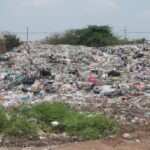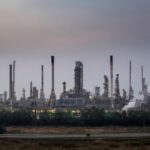Types of pollution are a significant concern in today’s world. One type is air pollution, which occurs when harmful substances are released into the air, leading to respiratory problems and environmental damage. Water pollution is another type, caused by the discharge of pollutants into water bodies, contaminating drinking water and harming aquatic life. Soil pollution refers to the contamination of soil by chemicals, pesticides, and industrial waste, making it unsuitable for agriculture. Noise pollution, characterized by excessive noise from various sources, can have detrimental effects on human health and well-being. Lastly, light pollution, caused by excessive artificial lighting, disrupts ecosystems and negatively impacts human sleep patterns. These various types of pollution highlight the urgent need for effective measures to mitigate and prevent their harmful effects.
There are several types of pollution that have detrimental effects on the environment and human health. These include air pollution, water pollution, soil pollution, noise pollution, and light pollution.
Air pollution refers to the contamination of the air by harmful substances such as gases, particles, and chemicals. Industrial emissions, vehicle exhausts, and burning fossil fuels contribute to the release of pollutants into the atmosphere. The consequences of air pollution include respiratory problems, cardiovascular diseases, and climate change.
Water pollution occurs when pollutants contaminate bodies of water, such as rivers, lakes, and oceans. Sources of water pollution include industrial waste, sewage, agricultural runoff, and oil spills. Polluted water can harm aquatic ecosystems, endanger marine life, and lead to the spread of diseases.
Soil pollution refers to the degradation of soil quality due to the presence of pollutants such as heavy metals, pesticides, and chemicals. Industrial activities, improper waste disposal, and the excessive use of agrochemicals are common causes of soil pollution. Contaminated soil can affect plant growth and food safety, as well as contaminate groundwater sources.
Noise pollution is the excessive or disturbing noise that disrupts the natural balance of sound in the environment. It is commonly caused by transportation, industrial activities, construction, and urbanization. Prolonged exposure to high levels of noise pollution can lead to hearing loss, stress, and sleep disturbances.
Light pollution occurs when artificial lighting alters the natural darkness of the night sky. It is mainly caused by urbanization, excessive outdoor lighting, and poorly designed lighting fixtures. Light pollution not only disrupts the sleep patterns of humans and animals but also affects the behavior of nocturnal creatures and interferes with astronomical observations.
In conclusion, the different types of pollution mentioned above have various detrimental effects on the environment and human well-being. It is crucial to raise awareness, implement regulations, and promote sustainable practices to combat and prevent pollution in order to protect our planet and future generations.
Air pollution
Air pollution refers to the contamination of the air with harmful substances, making it unsafe and unhealthy for living beings and the environment. It is caused by various natural and human activities, releasing pollutants that degrade the quality of air and pose significant risks to human health.
There are several sources of air pollution, both natural and man-made. Natural sources include volcanic eruptions, dust storms, and wildfires, which release large amounts of particulate matter and gases into the atmosphere. These natural events can have significant short-term effects on air quality.
However, it is human activities that have the most significant impact on air pollution. The burning of fossil fuels, such as coal, oil, and natural gas, is the primary source of air pollution. Industries, power plants, vehicles, and residential heating and cooking all contribute to the release of pollutants into the air.
The major air pollutants include particulate matter (PM), nitrogen oxides (NOx), sulfur oxides (SOx), carbon monoxide (CO), volatile organic compounds (VOCs), and hazardous air pollutants (HAPs). These pollutants can have various adverse effects on human health, ecosystems, and the environment.
Exposure to air pollution can lead to numerous respiratory and cardiovascular problems, including asthma, bronchitis, lung cancer, and heart disease. It can also cause irritation of the eyes, nose, and throat, worsening allergies and other respiratory conditions. The most vulnerable populations, such as children, the elderly, and those with pre-existing health conditions, are at higher risk of developing severe health issues due to air pollution.
Apart from human health, air pollution also has detrimental effects on the environment. It can harm plants, reducing crop yields and impacting biodiversity. Acid rain, a result of air pollution, damages forests, lakes, and aquatic ecosystems. Moreover, air pollution contributes to climate change by releasing greenhouse gases that trap heat in the atmosphere and disrupt the Earth’s climate patterns.
To combat air pollution, various measures have been implemented. Governments and regulatory bodies play a crucial role in developing and enforcing air quality standards and regulations. These include setting emission limits for industries, promoting cleaner fuel technologies, and regulating vehicle emissions.
Individuals can also contribute to reducing air pollution by adopting eco-friendly practices. This includes using public transportation or carpooling, reducing energy consumption, promoting renewable energy sources, and practicing proper waste management.
In conclusion, air pollution is a significant environmental and health issue caused by both natural phenomena and human activities. It poses severe risks to human health, ecosystems, and the environment. Taking proactive measures to reduce air pollution is crucial for safeguarding our well-being and preserving the planet for future generations.
Water pollution
Water pollution is a significant environmental issue that poses a threat to both aquatic life and human health. It occurs when pollutants, both organic and inorganic, contaminate water bodies such as rivers, lakes, and oceans. These pollutants can have various origins, including industrial activities, agricultural practices, urban development, and improper waste disposal. Water pollution can have severe consequences for ecosystems, as well as for the communities that rely on these water sources for drinking, irrigation, and recreational purposes.
One major source of water pollution is industrial activities. Industries often release harmful chemicals and substances into nearby water bodies through their effluent. These chemicals may include heavy metals, solvents, and various other toxic substances. When these pollutants enter the water, they can have detrimental effects on aquatic plants and animals. They can disrupt the balance of the ecosystem, leading to the decline or even extinction of certain species, and can ultimately impact the overall biodiversity of the area.
Similarly, agricultural practices also contribute to water pollution. The excessive use of fertilizers and pesticides in farming leads to runoff, where rainwater carries these chemicals into nearby rivers and lakes. This runoff can result in the eutrophication of water bodies, causing an overgrowth of algae and harmful aquatic plants. As a result, the oxygen levels in the water decrease, leading to the death of fish and other aquatic organisms. Furthermore, the use of antibiotics and hormones in livestock production can contaminate water sources, posing health risks to both animals and humans.
Urban development and improper waste disposal are additional sources of water pollution. In urban areas, stormwater runoff carries pollutants such as oil, chemicals, and litter from roads and buildings into nearby water bodies. This runoff can have adverse effects on the quality of water, making it unsafe for consumption and recreational purposes. Improper waste disposal, including the discharge of untreated sewage and garbage dumping into water bodies, further exacerbates water pollution. Pathogens and disease-causing organisms from these waste materials contaminate the water, posing a risk to those who come into contact with it.
The consequences of water pollution are diverse and wide-ranging. Not only does it harm marine life, but it also contaminates drinking water sources. Consumption of polluted water can lead to various health problems, such as gastrointestinal illnesses, respiratory issues, and even cancer. In addition, water pollution impacts the economy, as industries reliant on clean water sources may suffer disruptions or increased costs due to the need for water treatment and purification. Furthermore, the degradation of aquatic ecosystems affects recreational activities such as swimming, fishing, and boating.
Preventing and mitigating water pollution requires a multi-faceted approach. Strict regulations and enforcement are necessary to limit industrial waste discharge and ensure proper treatment of effluent. Sustainable agricultural practices, such as integrated pest management and responsible fertilizer use, can help reduce the pollution caused by farming. Improved waste management systems, including proper sewage treatment and recycling programs, are essential to combat urban pollution. Education and awareness campaigns also play a crucial role in promoting responsible individual behavior concerning water consumption and waste disposal.
In conclusion, water pollution is a grave concern that requires immediate attention. The contamination of water sources by industrial, agricultural, and urban activities poses serious threats to ecosystems and human life. Efforts must be made at all levels, from individual actions to government policies, to prevent and mitigate this ecological crisis. Protecting water sources ensures not only the health and well-being of aquatic life but also the sustainability and prosperity of communities that rely on these valuable resources.
Soil pollution
Soil pollution refers to the contamination of soil with harmful substances, leading to a decline in soil quality and negatively affecting the health of ecosystems. It is a significant environmental issue that can have severe consequences on both human health and the overall balance of our planet.
There are various sources of soil pollution, including industrial activities, agricultural practices, improper waste disposal, and the use of chemical fertilizers and pesticides. Industrial activities such as mining, manufacturing, and chemical production often release toxic substances into the soil, including heavy metals, solvents, and petroleum products. These types of contaminants can persist in the soil for extended periods, posing long-term risks to living organisms.
Agricultural practices also contribute to soil pollution through the excessive use of chemical fertilizers and pesticides. While these substances aim to enhance crop growth and protect against pests, their overuse and improper application can accumulate in soil and contaminate it. Moreover, the runoff from agricultural fields can carry these pollutants into nearby water bodies, further spreading soil pollution.
Improper waste disposal is another significant factor in soil pollution. When household and industrial waste is not adequately managed, harmful substances such as plastics, heavy metals, and toxic chemicals can seep into the soil, polluting it. Landfills, if not properly lined and maintained, can also leak hazardous substances into the surrounding soil and groundwater.
The consequences of soil pollution are widespread and devastating. Firstly, it affects soil fertility and agricultural productivity. Contaminants hinder the growth of plants, reduce crop yields, and can even render land unusable for cultivation. This not only impacts food production but also has economic implications for farmers and communities that rely on agriculture.
Secondly, soil pollution disrupts ecosystems as it affects organisms living in the soil. Soil organisms, including bacteria, fungi, earthworms, and insects, play crucial roles in nutrient cycling and maintaining soil structure. The presence of pollutants can harm these organisms, leading to imbalances in the soil ecosystem.
Moreover, soil pollution has far-reaching effects on human health. Contaminants in the soil can enter the food chain through plants, ultimately reaching humans. This can lead to various health issues, including respiratory problems, skin diseases, gastrointestinal disorders, and even certain types of cancer. Children are particularly vulnerable to the effects of soil pollution, as their immune systems are not fully developed.
Preventing and mitigating soil pollution requires concerted efforts from individuals, communities, and governments. Some effective measures include adopting sustainable agricultural practices like crop rotation and organic farming, promoting responsible waste management, and enforcing strict regulations on industrial pollution. Additionally, the remediation of polluted soil through techniques such as bioremediation and phytoremediation can help restore soil quality.
In conclusion, soil pollution is a pressing concern that must be addressed to safeguard both the environment and human health. By raising awareness, implementing sustainable practices, and taking proactive measures, we can work towards creating a cleaner and healthier future for our soils.
Noise pollution
Noise pollution refers to the excessive, annoying, or disturbing sounds that disrupt the natural environment and have a negative impact on human health and well-being. It is considered one of the most prevalent types of pollution in urban areas, where constant noise sources such as traffic, construction work, and industrial activities are abundant.
The effects of noise pollution on human health can be both physical and psychological. Prolonged exposure to loud noises can lead to hearing loss, especially in occupational environments where workers are exposed to high levels of noise. Additionally, noise pollution can cause sleep disturbances, which can lead to various health issues, including hypertension, cardiovascular diseases, and increased stress levels.
Beyond the immediate health effects on humans, noise pollution has detrimental effects on wildlife and the natural ecosystem as well. It disrupts animal communication patterns, making it difficult for them to locate mates, find food, or avoid predators. Birds, for instance, can be negatively impacted as noise pollution can interfere with their mating calls and breeding success. Marine mammals, such as whales and dolphins, can also suffer from noise pollution caused by ship traffic and underwater sonar systems, leading to disorientation and even strandings.
Noise pollution not only affects individuals but also has a significant impact on communities and society as a whole. It can disrupt daily activities and reduce overall quality of life. Excessive noise can interfere with concentration, productivity, and academic performance, leading to decreased cognitive abilities and learning difficulties, particularly in children.
Efforts to mitigate noise pollution are essential to ensure a healthy and peaceful environment. Governments and local authorities have implemented various measures to control and minimize noise pollution. These include setting noise limits for industrial and commercial activities, implementing zoning regulations to separate noise-sensitive areas from noise sources, and enforcing penalties for noise violations.
Individuals can also play a role in reducing noise pollution. Simple steps such as using earplugs or noise-cancelling headphones in noisy environments, adjusting sound systems to lower volumes, and maintaining vehicle sound systems adequately can significantly contribute to reducing individual noise pollution.
Research and technological advancements have also led to the development of noise barriers, soundproofing materials, and noise reduction technologies to mitigate the impact of noise pollution. For instance, urban planners and architects are now incorporating sound-absorbing materials and green spaces into building designs to create quieter and more peaceful urban environments.
In conclusion, noise pollution is a significant problem affecting both human health and the natural environment. It disrupts daily life, impairs cognitive abilities, and can have long-term effects on individuals and ecosystems. Addressing noise pollution requires collective efforts from governments, communities, and individuals to implement and follow regulations and adopt measures to minimize noise levels.
Light pollution
Light pollution, also known as photopollution or luminous pollution, refers to the excessive or misdirected artificial light produced by human activities that disrupts the natural darkness in the environment. It has become a significant global issue and is detrimental to both humans and other forms of life on Earth. This form of pollution primarily originates from urbanization and the widespread use of artificial lighting.
One of the major concerns associated with light pollution is its impact on wildlife and ecosystems. Many organisms rely on the natural cycles of day and night for vital biological processes such as reproduction, migration, and foraging. The presence of artificial light at night disrupts these natural patterns and can lead to various disruptions in their behavior. For example, nocturnal animals may experience altered mating behaviors or changes in their hunting and feeding routines due to the increased brightness in their habitats.
In addition to affecting wildlife, light pollution also has significant consequences for human health. The excessive exposure to artificial light disrupts the natural circadian rhythm, which regulates the sleep-wake cycle. Bright lights at night can interfere with the production of melatonin, a hormone that promotes sleep. Consequently, individuals living in areas with high levels of light pollution may experience sleep disorders, such as insomnia or sleep deprivation, which can have numerous negative effects on physical and mental health.
Furthermore, light pollution has adverse effects on astronomical observations. The urban sprawl and the use of improper lighting techniques result in a glow in the sky known as skyglow. This hazy glow makes it difficult to observe celestial objects and reduces the visibility of stars, planets, and other astronomical phenomena. This impacts both amateur and professional astronomers, hindering their ability to conduct research and limiting our understanding of the universe.
Light pollution also has economic implications. The overuse of artificial lighting leads to energy wastage, resulting in unnecessary financial costs and increasing the carbon footprint. By adopting more efficient lighting technologies, reducing unnecessary outdoor lighting, and implementing proper lighting practices, significant energy savings can be achieved, leading to cost reduction and a more sustainable approach to lighting.
To mitigate light pollution, various measures can be taken. Shielding outdoor lighting fixtures and directing the light downward instead of allowing it to scatter upwards can help in reducing light that is wasted or emitted into the night sky. The use of energy-efficient lighting sources, such as LEDs, can also significantly reduce light pollution. Additionally, implementing regulations and guidelines for outdoor lighting can promote responsible and sustainable practices, minimizing the impact on both human health and the environment.
In conclusion, light pollution has detrimental effects on various aspects of our lives, including wildlife, human health, astronomy, and energy consumption. It is crucial to raise awareness about this issue and take steps to reduce light pollution through responsible lighting practices and the use of efficient lighting technologies. By preserving the natural darkness of our environment, we can improve the well-being of both humans and the ecosystems we coexist with.













